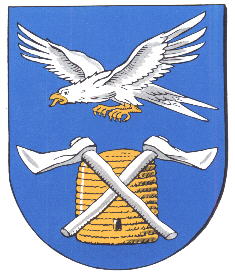Oldhorst: Difference between revisions
Jump to navigation
Jump to search
Knorrepoes (talk | contribs) m (Text replacement - "{{de}} '''" to "{{de}} '''") |
Knorrepoes (talk | contribs) m (Text replacement - "===Origin/meaning=== The" to "===Origin/meaning=== The") |
||
| Line 20: | Line 20: | ||
===Origin/meaning=== | ===Origin/meaning=== | ||
The arms were officially granted on July 25, 1965. | The arms were officially granted on July 25, 1965. | ||
The arms show a beehive and two typical axes used by beekeepers. The beehive and the axes symbolise the (historical) importance of beekeeping in the municipality. The red kite in the upper half of the arms was still breeding in the municipality at the time, and was nearly extinct in the larger region. | The arms show a beehive and two typical axes used by beekeepers. The beehive and the axes symbolise the (historical) importance of beekeeping in the municipality. The red kite in the upper half of the arms was still breeding in the municipality at the time, and was nearly extinct in the larger region. | ||
Revision as of 11:41, 18 July 2022
This page is part of the German heraldry portal Deutsche Wappensammlung |
Heraldry of the World |
|
German heraldry:
|
Selected collector's items from Germany:
|
OLDHORST
State : Niedersachsen
District (Kreis) : Hannover (2001 Region Hannover) (until 1974 Burgdorf)
Incorporated into : 1974 Burgwedel
| German | |
| English | No blazon/translation known. Please click here to send your (heraldic !) blazon or translation |
Origin/meaning
The arms were officially granted on July 25, 1965. The arms show a beehive and two typical axes used by beekeepers. The beehive and the axes symbolise the (historical) importance of beekeeping in the municipality. The red kite in the upper half of the arms was still breeding in the municipality at the time, and was nearly extinct in the larger region.
Contact and Support
Partners:
Your logo here ?
Contact us
© since 1995, Heraldry of the World, Ralf Hartemink 
Index of the site
Literature : Peters, 1974












